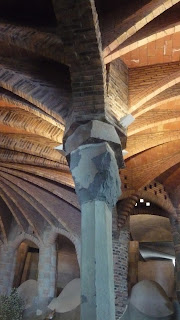Sunday, 11 August 2013
Colonia Güell and Gaudí's Crypt
The construction of Colonia Güell began in 1890 at the initiative of the entrepreneur Eusebi Güell in his textile estate of Santa Coloma de Cervelló. Construction of the factory began in 1890. A mere year later the first building was completed and the steam machine dedicated to spinning was started. Afterwards, the rest of the buildings, each aimed at drying, tinting, etc in order to complete cotton’s process of transformation. Each of the buildings that made up the factory had a different role in the process of transforming cotton into fabric. A set of rails and cartwheels were installed throughout the factory in order to facilitate the transportation of materials between the aforementioned buildings.
The factory of the Colonia Güell was its central nucleus and raison d’etre. Dedicated to the production of several types of cloths, its main difference with other textile factories of the time was that it used coal in lieu of hydraulic energy.
Industrial colonies where conceived as a socioeconomic organization whose main goal was industrial productivity. The mill took up most of the time of the men and women of the colony, for them it was the guarantee of having a regular income in times of economic scarcity. In contrast to most industrial colonies in Catalonia, Güell worked to improve the social conditions of his workers and applied his cultural patronage in the Colonia, providing it with cultural and religious facilities of a modernist design which were developed by different architects, most notably Antoni Gaudí to whom he entrusted in 1898 the building of the church.
Over the next few years, Gaudí carried out various preliminary studies which culminated in a model which was placed in a pavilion located in the hill were the building would later be erected. The construction of the temple began in 1908. However, the ambitious project which foresaw a church with two naves, lower and upper, topped by different towers and a 40 meters high central dome would remain unfinished. In 1914 the Güell family decided to stop financing the church and Gaudí abandoned the project. In November 1915 the bishop of Barcelona consecrated the lower nave, the only one to have been built, which made the church be popularly known as the crypt.
During the textile crisis of 1973 the mill ceased its production which had a big social impact in the Colonia. Over the next few years, the property was sold; the mill was divided and sold to different companies, the houses to their inhabitants and the facilities and land to the public institutions.
In 1990 the Colonia Güell was declared 'Heritage of Cultural Interest' by the Spanish government and the protection of some of its most relevant buildings was established. The Crypt was declared a World Heritage Site by UNESCO in 2005.
Visitors can still walk around the industrial Colonia and visit Gaudí's church, all the while observing beautiful, singular buildings created by modernist architects.
The Crypt of Colònia Güell is a culminating point in Gaudi's work including for the first time practically all of his architectural innovations. He stated that without the large-scale experiments he undertook there, he would not have dared apply those same geometries to the Sagrada Familia. It is the place where, according to Japanese architect, Arata Isozaki, he ‘overcame all established limits regarding shapes.’
--------------------------------------------------------------------------------------------
Gungor - Beautiful Things.
Subscribe to:
Post Comments (Atom)





























No comments:
Post a Comment